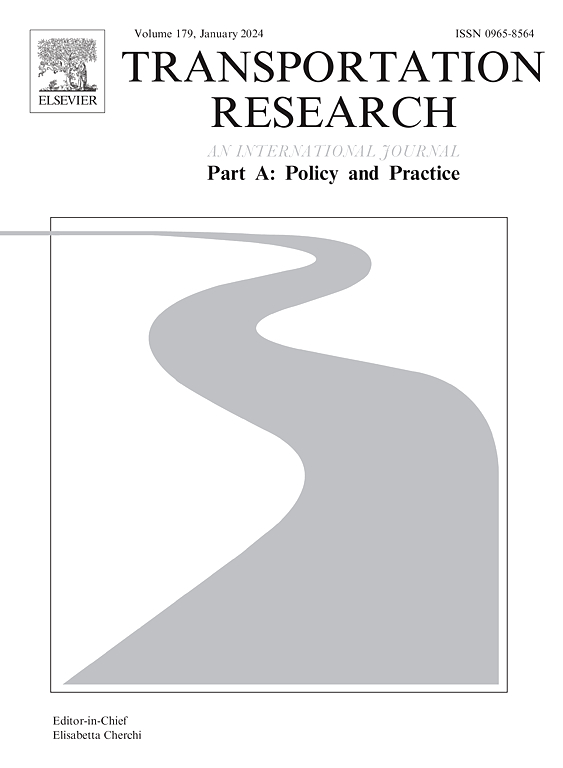Greening the commute: A case study of demand for employer-sponsored microtransit
IF 6.3
1区 工程技术
Q1 ECONOMICS
Transportation Research Part A-Policy and Practice
Pub Date : 2024-10-23
DOI:10.1016/j.tra.2024.104258
引用次数: 0
Abstract
Demand-responsive, pooled, app-based transportation services, often known as microtransit, fill a gap in providing public transportation where fixed-route transit services are weak. While prior research mostly focused on public-access microtransit services, little is known about the potential of restricted-access, employer-sponsored services to achieve mode shifts away from driving. This study investigates the possible use of employer-sponsored microtransit service by commuters who currently drive to work, using data from a stated choice experiment conducted at a major medical center in Columbus, Ohio. The results reveal a considerable interest in a hypothetical microtransit commuter service among medical center employees, with on average 29.6% of them shifting from car to microtransit. Overall, relatively few sociodemographic characteristics are found to correlate with interest in employer-sponsored microtransit use, but income, status as a shift worker, and a desire to work while commuting are found to affect choice. Valuations of in-vehicle travel time, flexibility in drop-off/pick-up time, and stop location are calculated and compared to prior results from the transit literature. Such valuations can serve as inputs for optimization models to design microtransit systems. Furthermore, respondents’ potential concerns about a microtransit service and reactions to proposed incentive schemes are analyzed. The study results highlight the value of combining employer-sponsored microtransit implementations with transportation demand management strategies that reduce the attractiveness of commuting by car. The findings suggest that employer-sponsored microtransit represents an opportunity to reduce greenhouse gas emissions and congestion in an industry sector that employs 6.6 million workers in the US.
绿色通勤:雇主赞助的微型公交需求案例研究
响应需求、集合式、基于应用程序的交通服务,通常被称为微型公交,填补了固定路线公交服务薄弱的公共交通空白。以往的研究大多集中在公共交通的微型公交服务上,而对于限制进入、由雇主赞助的服务在实现驾驶模式转变方面的潜力却知之甚少。本研究利用在俄亥俄州哥伦布市一家大型医疗中心进行的陈述选择实验数据,调查了目前开车上班的通勤者使用雇主赞助的微型公交服务的可能性。研究结果表明,医疗中心的员工对假设的微型公交通勤服务相当感兴趣,平均有 29.6% 的员工从开车转向乘坐微型公交。总体而言,与对雇主赞助的微型公交使用兴趣相关的社会人口特征相对较少,但发现收入、轮班工作者身份和通勤时工作的愿望会影响选择。我们计算了车内旅行时间、上下车时间灵活性和站点位置的价值,并将其与公交文献中的先前结果进行了比较。这些估值可作为设计微型公交系统的优化模型的输入。此外,还分析了受访者对微型公交服务的潜在顾虑以及对拟议激励方案的反应。研究结果强调了将雇主赞助的微型公交实施与交通需求管理策略相结合的价值,这种策略可以降低驾车通勤的吸引力。研究结果表明,雇主赞助的微型公交是减少温室气体排放和交通拥堵的一个机会,该行业在美国雇佣了 660 万工人。
本文章由计算机程序翻译,如有差异,请以英文原文为准。
求助全文
约1分钟内获得全文
求助全文
来源期刊
CiteScore
13.20
自引率
7.80%
发文量
257
审稿时长
9.8 months
期刊介绍:
Transportation Research: Part A contains papers of general interest in all passenger and freight transportation modes: policy analysis, formulation and evaluation; planning; interaction with the political, socioeconomic and physical environment; design, management and evaluation of transportation systems. Topics are approached from any discipline or perspective: economics, engineering, sociology, psychology, etc. Case studies, survey and expository papers are included, as are articles which contribute to unification of the field, or to an understanding of the comparative aspects of different systems. Papers which assess the scope for technological innovation within a social or political framework are also published. The journal is international, and places equal emphasis on the problems of industrialized and non-industrialized regions.
Part A''s aims and scope are complementary to Transportation Research Part B: Methodological, Part C: Emerging Technologies and Part D: Transport and Environment. Part E: Logistics and Transportation Review. Part F: Traffic Psychology and Behaviour. The complete set forms the most cohesive and comprehensive reference of current research in transportation science.

 求助内容:
求助内容: 应助结果提醒方式:
应助结果提醒方式:


